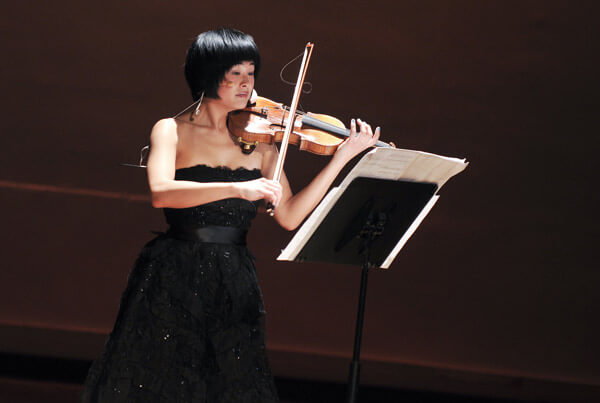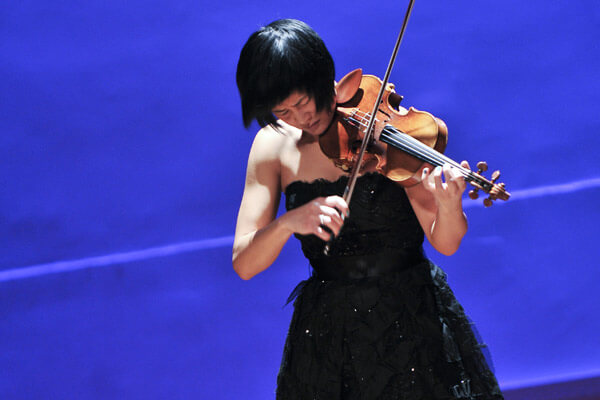 The magnificent geometries of Johann Sebastian Bach don’t really need any assistance in being kept current – if ever the overused adjective “timeless” has applied it’s to him – but Columbia University’s Miller Theatre has set about stretching the four century gap under the banner Bach, Revisited, a series of three concerts pairing the master’s work with contemporary composers, the first of which occurred Thursday, February 6.
The magnificent geometries of Johann Sebastian Bach don’t really need any assistance in being kept current – if ever the overused adjective “timeless” has applied it’s to him – but Columbia University’s Miller Theatre has set about stretching the four century gap under the banner Bach, Revisited, a series of three concerts pairing the master’s work with contemporary composers, the first of which occurred Thursday, February 6.

Jennifer Koh – Photo by Jenny Anderson
The Bach run has long been a part of Miller’s programming, evolving over the years to take historical perspectives or include modern interpretation. This year, for the theater’s 25th anniversary, three composers were invited to select a work of Bach’s to be presented alongside one of their own, starting with the Finnish composer Kaija Saariaho, whose 2011 Frises was given its US premiere alongside Bach’s Partita No. 2 in D minor.
The two violin solos were played by the brilliant Jennifer Koh, a musician committed to the canon as well as the contemporary. She has performed both Bach and Saariaho at Miller in the past and has often presented all six of Bach’s Sonatas and Partitas in a single concert. Her three-evening Bach and Beyond project pairs the Sonatas and Partitas with Saariaho, Carter, Berio, Bartok, Phil Kline and other contemporary composers. She was, in other words, the fiddler for the job. She stood with feet firmly planted, exhibiting musculature and finesse for the demanding quarter hour. The Sonatas and Partitas were perhaps considered an incidental exercise during Bach’s life, but they have become standard repertoire today – at least for the violinist with the fortitude to manage it. Koh rose to the job impressively.
In a post-concert talk, Saariaho said she took inspiration for her Frises from the partitas’ “continuous, organic transformations and variations” even if she doesn’t adhere to the sorts of structure from which Bach’s music is built. “I never usually use forms. I don’t think in those terms. I don’t think I need a sonata form – or especially rondo,” she added with a laugh. “I don’t like those.”

Kaija Saariaho – Photo Jean-Louis Fernandez
It’s perhaps ironic, then, that the concert was the second time in a week that one of Saariaho’s compositions was paired with a baroque composer. On February 1, as a part of the daylong Music of Now Marathon at Symphony Space, cellist Nicole Johnson played her Dreaming Chaconne alongside Giuseppe Colombi’s Ciaconna a basso solo. In both concerts there was a feeling of formality slowly slipping away from the older to the newer piece. Saariaho may not use form, but she certainly uses its tools. Like Dreaming Chaconne, Frises referenced the older piece’s chaconne form with a bass line guiding the variations in melody, even if those variations didn’t adhere strictly to form.
That reverence is what gives Saariaho’s work its particular resonance. Speaking onstage with with Koh and Miller Theater Executive Director Melissa Smey, the composer said that Bach’s work is “maybe the only music that I never get tired of. Everybody has a very special relationship with Bach, and that’s amazing. Everybody feels that ‘only I know how Bach is played.’”
In a wonderful programming move, Koh played Frises twice, once before and once after the intermission, affording a better opportunity to absorb the abstract piece, which bordered on the disorienting with its use of electronic delay. The piece began softly on the D upon which the partita ended and grew in volume only slowly as ghostly chimes (triggered by Jean-Baptiste Barrière, who managed the electronic elements of the performance) came from the speakers. The score hovered around that common D for the first movement, allowing Koh room to improvise, creating a suggestion of the partitia slowing nearly to a halt – not mirroring the Bach but retaining much of the feel. As it dissolved, a more direct electronic effect was introduced, instilling a reverberation that created a sort of harmonic halo around the violin.

Jennifer Koh – Photo by Jenny Anderson
The second movement added the chaconne ground bass along with a digital delay, a sharp slap-back punctuating the ends of lines (triggered by Koh via a foot pedal). The violin, then, grew more intense, as if trying to outmatch it’s own echo. Here again, the lines grew blurry – not melting away as in the first movement but overlapping and interrupting each other. The third movement dealt in waves that threatened to eclipse the violin, and finally in the fourth the bass triplets returned as it slowed to the halting tempo of the first movement and returned to the final D. Hearing the piece a second time allowed a more relaxed listen while creating some tricks of perception. Familiarity made it seem faster and it was easier to take the electronics for granted and focus on Koh’s precise playing. As with the Bach, she was wonderful, and as accomplished as she is at playing Bach, she admitted during the interview to some butterflies.
“I find it very terrifying to play it in public,” she said. “It’s so personal, and so fragile.”
The series continues on April 17 with works of Joan Tower and the 5th Brandenburg Concerto. On May 15, Steve Reich’s Tehillium will be paired with the work which inspired it, Bach’s Easter Cantata, Christ Lags in Todes Banden. Jean-Baptiste Barrière’s work will be represented at Miller on March 29 with a free matinee concert and an evening Composer Portrait concert, along with a lobby audio installation from March 24-29.























